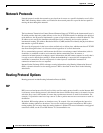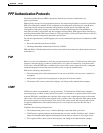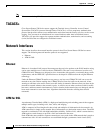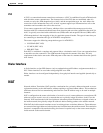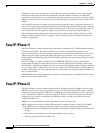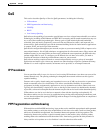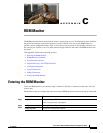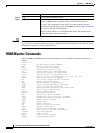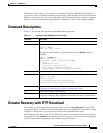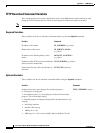
B-7
Cisco Secure Router 520 Series Software Configuration Guide
OL-14210-01
Appendix B Concepts
QoS
QoS
This section describes Quality of Service (QoS) parameters, including the following:
• IP Precedence
• PPP Fragmentation and Interleaving
• CBWFQ
• RSVP
• Low Latency Queuing
QoS refers to the capability of a network to provide better service to selected network traffic over various
technologies, including ATM, Ethernet and IEEE 802.1 networks, and IP-routed networks that may use
any or all of these underlying technologies. Primary goals of QoS include dedicated bandwidth,
controlled jitter and latency (required by some real-time and interactive traffic), and improved loss
characteristics. QoS technologies provide the elemental building blocks for future business applications
in campus, WAN, and service provider networks.
QoS must be configured throughout your network, not just on your router running VoIP, to improve voice
network performance. Not all QoS techniques are appropriate for all network routers. Edge routers and
backbone routers in your network do not necessarily perform the same operations; the QoS tasks they
perform might differ as well. To configure your IP network for real-time voice traffic, you need to
consider the functions of both edge and backbone routers in your network.
QoS software enables complex networks to control and predictably service a variety of networked
applications and traffic types. Almost any network can take advantage of QoS for optimum efficiency,
whether it is a small corporate network, an Internet service provider, or an enterprise network.
IP Precedence
You can partition traffic in up to six classes of service using IP Precedence (two others are reserved for
internal network use). The queuing technologies throughout the network can then use this signal to
expedite handling.
Features such as policy-based routing and committed access rate (CAR) can be used to set precedence
based on extended access-list classification. This allows considerable flexibility for precedence
assignment, including assignment by application or user, by destination and source subnet, and so on.
Typically this functionality is deployed as close to the edge of the network (or administrative domain)
as possible, so that each subsequent network element can provide service based on the determined policy.
IP Precedence can also be set in the host or network client with the signaling used optionally. IP
Precedence enables service classes to be established using existing network queuing mechanisms (such
as class-based weighted fair queuing [CBWFQ]) with no changes to existing applications or complicated
network requirements.
PPP Fragmentation and Interleaving
With multiclass multilink PPP interleaving, large packets can be multilink-encapsulated and fragmented
into smaller packets to satisfy the delay requirements of real-time voice traffic; small real-time packets,
which are not multilink encapsulated, are transmitted between fragments of the large packets. The
interleaving feature also provides a special transmit queue for the smaller, delay-sensitive packets,
enabling them to be transmitted earlier than other flows. Interleaving provides the delay bounds for
delay-sensitive voice packets on a slow link that is used for other best-effort traffic.






